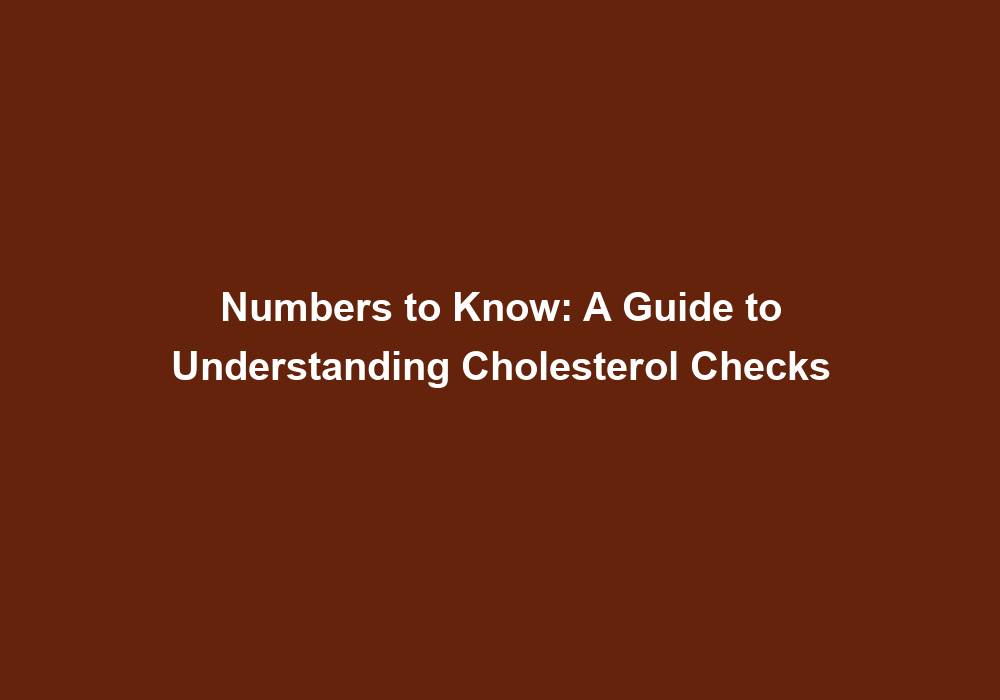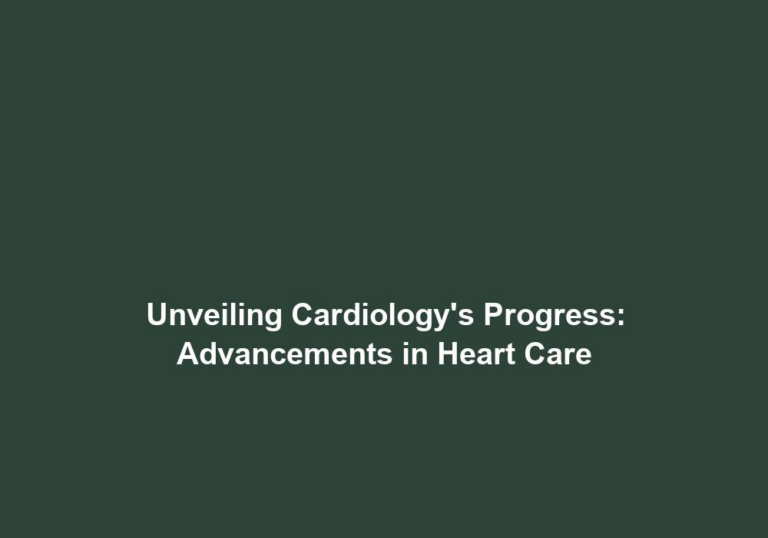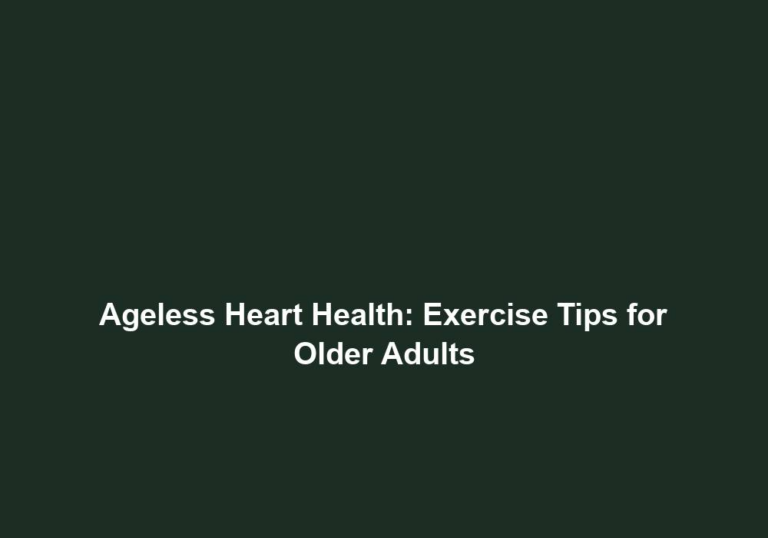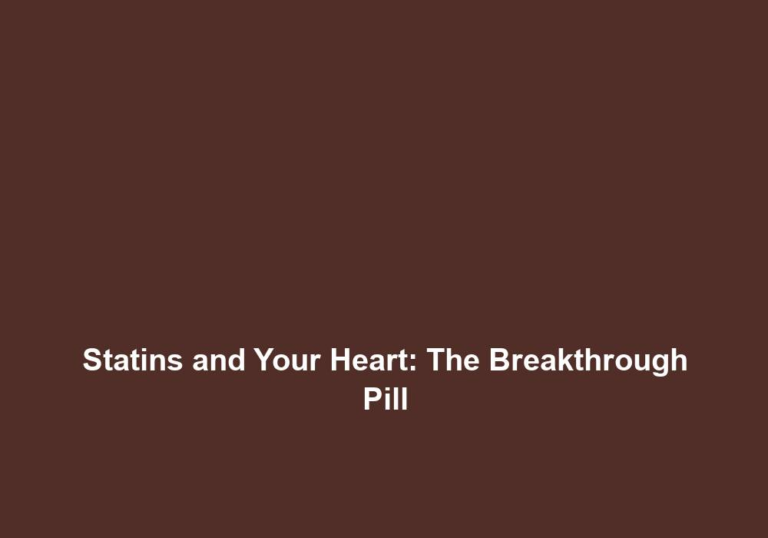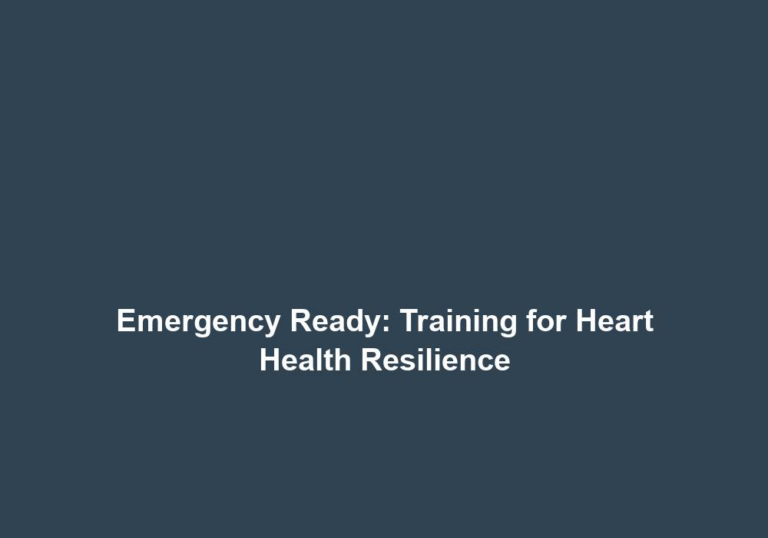Numbers to Know: A Guide to Understanding Cholesterol Checks
Cholesterol is a vital component of our body, playing a crucial role in various processes. However, when cholesterol levels become imbalanced, it can lead to serious health issues such as heart disease. That’s why it’s important to regularly monitor and understand our cholesterol levels through cholesterol checks. In this comprehensive guide, we will delve into the numbers you need to know and provide you with a thorough understanding of cholesterol checks.
What is Cholesterol?
Cholesterol is a waxy, fat-like substance that is naturally produced in the liver and found in certain foods. It serves as an essential building block for cell membranes, hormone production, and the synthesis of vitamin D. However, there are two types of cholesterol that have different effects on our health:
-
Low-Density Lipoprotein (LDL) Cholesterol: LDL cholesterol is often referred to as bad cholesterol since it can accumulate in the arteries, leading to plaque formation and increasing the risk of heart disease. When LDL cholesterol levels are high, it can contribute to the narrowing of the arteries, a condition known as atherosclerosis. This can restrict blood flow to vital organs, including the heart and brain, and increase the risk of heart attack or stroke. It is important to keep LDL cholesterol levels within a healthy range to minimize these risks.
-
High-Density Lipoprotein (HDL) Cholesterol: HDL cholesterol is known as good cholesterol as it helps remove LDL cholesterol from the bloodstream, reducing the risk of heart disease. HDL cholesterol acts as a scavenger, picking up excess cholesterol from the arteries and transporting it back to the liver for processing and elimination. Higher levels of HDL cholesterol are desirable as they help maintain a healthy balance of cholesterol in the body.
Understanding Cholesterol Checks
Cholesterol checks, also known as lipid profiles or lipid panels, are blood tests that measure your cholesterol levels. They provide valuable insights into your cardiovascular health and help identify any potential risks or imbalances. Here are the key numbers to know and understand when it comes to cholesterol checks:
Total Cholesterol Level
Total cholesterol represents the sum of your LDL, HDL, and other lipid components. It is an important number to monitor, but it doesn’t provide a complete picture of your cardiovascular health on its own. The desirable range for total cholesterol is generally below 200 milligrams per deciliter (mg/dL). However, it’s important to note that total cholesterol alone does not differentiate between LDL and HDL cholesterol levels. Therefore, it is necessary to assess the individual cholesterol components to get a better understanding of your cardiovascular health.
LDL Cholesterol Level
LDL cholesterol is often the primary focus of cholesterol checks because of its negative impact on heart health. Higher levels of LDL cholesterol increase the risk of plaque buildup in the arteries, leading to atherosclerosis. The optimal range for LDL cholesterol depends on various factors such as personal risk factors and existing medical conditions. However, in general, an LDL cholesterol level below 100 mg/dL is considered optimal for people at high risk of heart disease.
It’s important to note that LDL cholesterol levels alone may not provide a complete picture of your cardiovascular health. Factors such as the size and density of LDL particles, as well as the presence of other risk factors, should be taken into consideration. Your healthcare provider can help interpret your LDL cholesterol levels in the context of your overall health and provide personalized recommendations.
HDL Cholesterol Level
HDL cholesterol, on the other hand, is considered beneficial for heart health. It helps remove excess cholesterol from the bloodstream, preventing the buildup of plaque in the arteries. Higher levels of HDL cholesterol are desirable, and a level above 60 mg/dL is considered ideal for reducing the risk of heart disease.
Increasing your HDL cholesterol levels can be achieved through lifestyle modifications such as regular exercise, maintaining a healthy weight, and consuming a diet rich in healthy fats, such as olive oil, avocados, and fatty fish. However, it’s important to note that HDL cholesterol levels alone do not provide a complete picture of your cardiovascular health. Your healthcare provider will consider other factors, such as your LDL cholesterol levels and overall risk profile, when assessing your heart health.
Triglyceride Level
Triglycerides are another type of fat found in the blood. Elevated triglyceride levels are often associated with metabolic disorders, such as obesity and insulin resistance. They can also be influenced by dietary factors, such as consuming a high-carbohydrate or high-sugar diet. The recommended range for triglycerides is typically below 150 mg/dL.
High triglyceride levels can contribute to the development of atherosclerosis and increase the risk of heart disease. Lifestyle modifications, such as adopting a healthy diet and engaging in regular physical activity, can help lower triglyceride levels. Limiting the intake of refined carbohydrates, sugary beverages, and alcohol can also be beneficial in managing triglyceride levels.
Ratio of Total Cholesterol to HDL Cholesterol
Calculating the ratio of total cholesterol to HDL cholesterol provides a more comprehensive assessment of cardiovascular risk. A higher ratio indicates an increased risk, while a lower ratio suggests a lower risk. Ideally, the ratio should be below 5:1, with lower ratios being better.
A high total cholesterol to HDL cholesterol ratio may indicate a higher risk of heart disease, even if individual cholesterol levels are within the desirable range. This ratio can be influenced by various factors, including genetics, lifestyle choices, and underlying medical conditions. Your healthcare provider can help interpret your ratio and recommend appropriate interventions, if necessary.
Interpreting Cholesterol Check Results
Understanding your cholesterol check results is crucial for maintaining good heart health. Here’s a breakdown of how to interpret different levels:
-
Desirable: Total cholesterol below 200 mg/dL, LDL cholesterol below 100 mg/dL, HDL cholesterol above 60 mg/dL, and triglycerides below 150 mg/dL.
-
Borderline High: Total cholesterol between 200-239 mg/dL, LDL cholesterol between 100-159 mg/dL, HDL cholesterol between 40-59 mg/dL, and triglycerides between 150-199 mg/dL.
-
High: Total cholesterol above 240 mg/dL, LDL cholesterol above 160 mg/dL, HDL cholesterol below 40 mg/dL, and triglycerides above 200 mg/dL.
If your cholesterol levels fall outside the desirable range, it’s important to consult with your healthcare provider for further evaluation and appropriate management strategies, which may include lifestyle changes, medication, or a combination of both.
Tips for Maintaining Healthy Cholesterol Levels
Beyond cholesterol checks, you can take proactive steps to maintain healthy cholesterol levels. Here are some tips:
-
Eat a Heart-Healthy Diet: Incorporate foods rich in fiber, such as whole grains, fruits, vegetables, and legumes. These foods can help lower LDL cholesterol levels and improve overall heart health. Limit your intake of saturated and trans fats found in fatty meats, full-fat dairy products, and fried foods.
-
Engage in Regular Physical Activity: Regular exercise can help increase HDL cholesterol levels and improve cardiovascular health. Aim for at least 150 minutes of moderate-intensity aerobic exercise per week. This can include brisk walking, cycling, swimming, or any activity that gets your heart rate up.
-
Achieve and Maintain a Healthy Weight: Excess weight, especially around the waistline, can contribute to higher cholesterol levels. Aim for a Body Mass Index (BMI) within the healthy range by adopting a balanced diet and engaging in regular physical activity.
-
Avoid Smoking and Limit Alcohol Consumption: Smoking damages blood vessels and lowers HDL cholesterol levels. Excessive alcohol consumption can increase triglyceride levels and contribute to weight gain. Quitting smoking and limiting alcohol intake can have a positive impact on your cholesterol levels and overall heart health.
-
Manage Stress: Chronic stress can negatively impact cholesterol levels. Practice stress-reducing techniques such as meditation, deep breathing exercises, or engaging in hobbies you enjoy. These activities can help lower stress levels and promote better heart health.
By following these lifestyle modifications and staying vigilant with cholesterol checks, you can actively promote your cardiovascular health and reduce the risk of heart disease.
Conclusion
Understanding the numbers derived from cholesterol checks is essential for assessing your cardiovascular health. By knowing your total cholesterol, LDL cholesterol, HDL cholesterol, triglyceride levels, and their optimal ranges, you can take proactive steps to maintain healthy cholesterol levels. Remember to consult with your healthcare provider for personalized guidance and recommendations tailored to your unique health profile. With a combination of regular cholesterol checks, healthy lifestyle choices, and appropriate interventions, you can actively safeguard your heart health for years to come.
Note: The above content is provided in markdown format for the given title.

